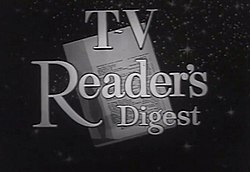| Date | Title | Actor(s) |
|---|
| January 17, 1955 | "Last of the Old Time Shooting Sheriffs" [9] | -- |
| January 24, 1955 | "Trouble on the Double" | Peter Graves, Nancy Gates [10] |
| January 31, 1955 | "The Most Unforgettable Character" | Martha Scott, Douglass Montgomery [a] |
| February 7, 1955 | "How Chance Made Lincoln President" | Richard Gaines, Vivi Janiss [12] |
| February 14, 1955 | "I'd Pick More Daisies" | Richard Denning, Jeanne Cagney [13] |
| February 21, 1955 | "Top Secret" [9] | -- |
| February 28, 1955 | "A Matter of Life or Death" | Bobby Driscoll, Minor Watson, Jimmy Ogg, Erville Anderson [14] |
| March 7, 1955 | "The End of Blackbeard the Pirate" | Jeff Morrow, Randy Farr, Keith Hitchcock [15] |
| March 14, 1955 | "The American Master Counterfeiters" [9] | -- |
| March 21, 1955 | "America's First Great Lady" | Gloria Talbott [16] |
| March 28, 1955 | "The Manufactured Clue" | Chuck Connors, Paul Stewart, Douglas Spencer [17] |
| April 4, 1955 | "Incident on the China Coast" | Bob Bray, Ann Doran [18] |
| April 11, 1955 | "How Charlie Faust Won a Pennant for the Giants" | Lee Marvin, Alan Reed [19] [b] |
| April 18, 1955 | "Honeymoon in Mexico" | Richard Long, Merry Anders [21] |
| April 25, 1955 | "The Great Armored-Car Robbery" [9] | -- |
| May 2, 1955 | "A Million Dollar Story" | Bill Bouchey, James Bell, Julie Bishop [22] |
| May 9, 1955 | "Dear Friends and Gentle Hearts" | Johnny Johnston, Joan Camden [c] |
| May 16, 1955 | "France's Greatest Detective" [9] | -- |
| May 23, 1955 | "Around the Horn to Matrimony" | Robert Hutton, Donna Martell [23] |
| May 30, 1955 | "The Anatomy of Graft" | Gene Barry, Jaclynne Greene, Emerson Treacy [24] |
| June 6, 1955 | "Human Nature Through a Rear View Mirror" [9] | -- |
| June 13, 1955 | "Mr. Pak Takes Over" | Philip Ahn, Kenneth Tobey [25] |
| June 20, 1955 | "My First Bullfight" | Jack Kelly [26] |
| June 27, 1955 | "Comrade Lindeman's Conscience" [9] | -- |
| July 4, 1955 | "Six Hours of Surgery" | Walter Kingsford, Jerry Paris, Damian O'Flynn, Jean Byron [27] |
| July 11, 1955 | "The Baron and His Uranium Killing" | Marcel Dalio, Steven Geray [28] |
| October 24, 1955 | "Old Master Detective" | William Talman, Walter Kingsford, Jesse White [29] [30] |
| October 31, 1955 | "The Archer-Shee Case" [9] | -- |
| November 7, 1955 | "The Brainwashing of John Hays" [9] | -- |
| November 14, 1955 | "The Making of a Submariner" [9] | -- |
| November 21, 1955 | "The Voyage of Capt. Tom Jones, Pirate" | Louis Hayward [31] |
| December 12, 1955 | "Emergency Case" [9] | -- |
| January 2, 1956 | "In the Eye of the Hurricane" [9] | -- |
| January 16, 1956 | "The Man Who Beat Death" [9] | -- |
| January 23, 1956 | "A Bell for Okinawa" [9] | -- |
| February 13, 1956 | "Texas in New York" | Marilyn Erskine [7] |
| February 27, 1956 | "Case of the Uncertain Hand" | Marguerite Chapman [5] |
| March 12, 1956 | "Night Court" [9] | -- |
| April 23, 1956 | "Uncle Sam's C-Men" [9] | -- |
| May 7, 1956 | "The Old, Old Story" | Rosemary DeCamp [6] |
| May 14, 1956 | "Britain's Most Baffling Murder Case" [9] | -- |
| June 18, 1956 | "Go Fight City Hall" [9] | Gene Raymond, Jean Byron, Joan Young [4] |
| June 25, 1956 | "Family Reunion, U.S.A." [9] | -- |
